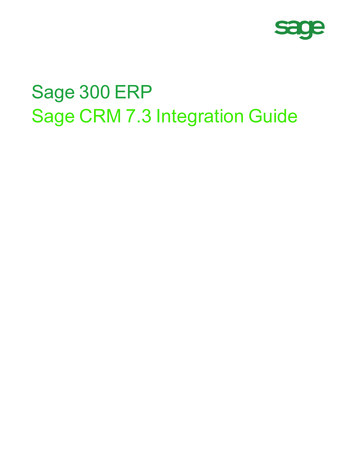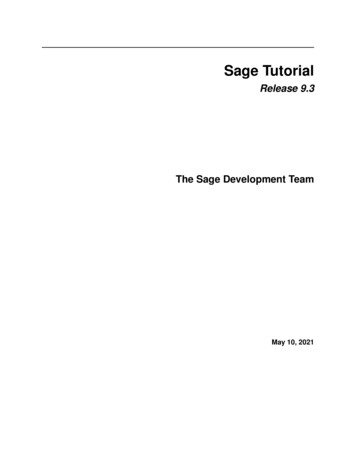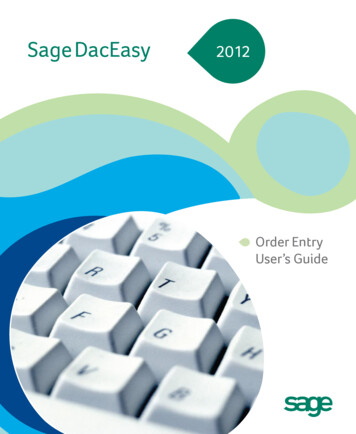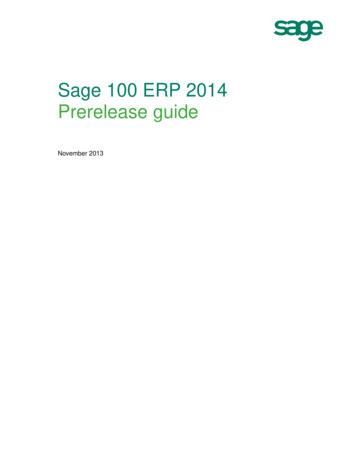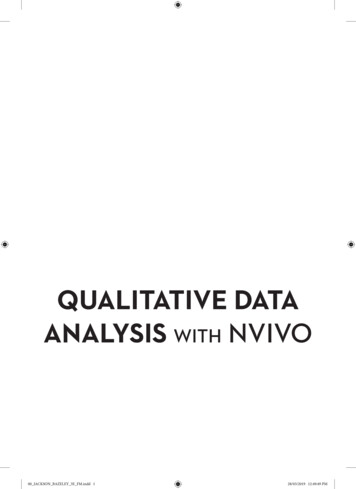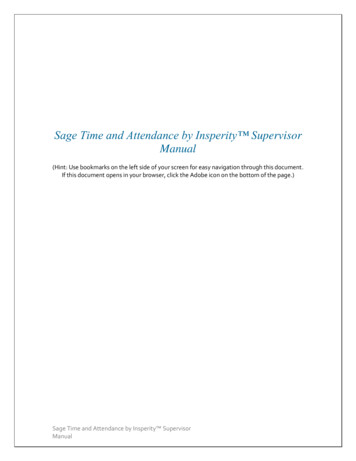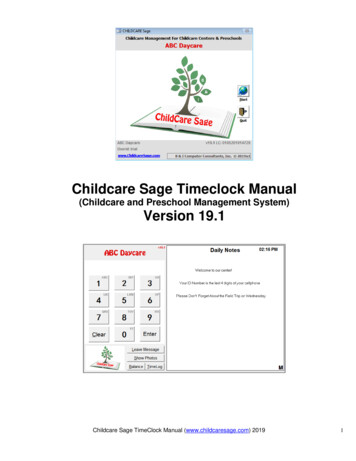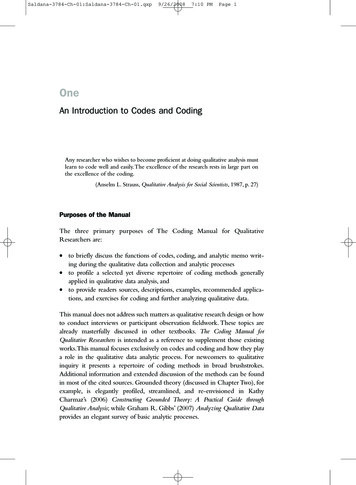
Transcription
7:10 PMPage 1OneAn Introduction to Codes and CodingAny researcher who wishes to become proficient at doing qualitative analysis mustlearn to code well and easily.The excellence of the research rests in large part onthe excellence of the coding.(Anselm L. Strauss, Qualitative Analysis for Social Scientists, 1987, p. 27)Purposes of the ManualThe three primary purposes of The Coding Manual for QualitativeResearchers are: to briefly discuss the functions of codes, coding, and analytic memo writing during the qualitative data collection and analytic processes to profile a selected yet diverse repertoire of coding methods generallyapplied in qualitative data analysis, and to provide readers sources, descriptions, examples, recommended applications, and exercises for coding and further analyzing qualitative data.This manual does not address such matters as qualitative research design or howto conduct interviews or participant observation fieldwork. These topics arealready masterfully discussed in other textbooks. The Coding Manual forQualitative Researchers is intended as a reference to supplement those existingworks.This manual focuses exclusively on codes and coding and how they playa role in the qualitative data analytic process. For newcomers to qualitativeinquiry it presents a repertoire of coding methods in broad brushstrokes.Additional information and extended discussion of the methods can be foundin most of the cited sources. Grounded theory (discussed in Chapter Two), forexample, is elegantly profiled, streamlined, and re-envisioned in KathyCharmaz’s (2006) Constructing Grounded Theory: A Practical Guide throughQualitative Analysis; while Graham R. Gibbs’ (2007) Analyzing Qualitative Dataprovides an elegant survey of basic analytic processes.
87:10 PMPage 2THE CODING MANUAL FOR QUALITATIVE RESEARCHERSThe Coding Manual does not maintain allegiance to any one specificresearch genre or methodology. Throughout this book you’ll read a breadthof perspectives on codes and coding, sometimes purposely juxtaposed toillustrate and highlight the diverse opinions among scholars in the field. Noone, including myself, can claim final authority on the “best” way to codequalitative data. In fact, there are a few instances where I take moderate liberty with adapting and even renaming prescribed coding methods for clarityor flexibility’s sake. This is not intended to standardize terminology withinthe field, but simply to employ consistency throughout this particular manual. My perspective acknowledges and promotes the pragmatist paradigm(Patton, 2002), which chooses “the right tool for the right job” since allresearch questions, methodologies, conceptual frameworks, and fieldworkparameters are context-specific.I also wrote this manual because I find it problematic (but not difficult) toteach coding in my own qualitative research methods course. I provide studentswith an array of readings about the process from multiple sources because Ihave yet to find that single satisfactory book (to me) that focuses exclusivelyon the topic. General introductory texts in qualitative inquiry are so numerousand well-written that it becomes difficult not to find the best one to use, butwhich one of such quality works to select as the primary textbook.This manual supplements introductory works in the subject because most limit their discussions about coding to the writer’s prescribed, preferred, or signaturemethods. I wanted to provide in a single resource a selected collection of various coding methods developed by other researchers (and myself) that providesstudents and colleagues a handy reference for classroom exercises and assignments, and for their own independent research for thesis and dissertation fieldwork and future qualitative studies. But by no means is it an exhaustiveresource. I deliberately exclude such discipline-specific methods as BehaviorCoding (which notes problematic respondent and interviewer behaviors during survey interviews [Singleton & Straits, 2002, p. 65]) and such signaturemethods as the Davis Observation Code system (for medical interviews [Zoppi& Epstein, 2002, p. 375]). If you need additional information and explanationabout the coding methods, check the References.The Coding Manual is intended primarily as a reference work. It is not necessarily meant to be read cover-to-cover, but it certainly can be if you wish toacquaint yourself with all 29 coding methods profiles and their analytic possibilities. There are, in fact, several principles related to coding matters not discussed in the first two chapters that are unique to some of the profiles. If youchoose to review all the contents, read selected sections at a time, not all of themin one sitting, otherwise it can overwhelm you. If you’re scanning the manual tosee which coding method(s) might be appropriate for your particular study,
7:10 PMPage 33AN INTRODUCTION TO CODES AND CODINGread the profiles’ Description and Applications sections to see if further readingof the profile is merited. It’s doubtful you’ll use every coding method includedin this manual for your particular research endeavors throughout your career,but they are available here on an “as needed” basis for your unique projects.Like an academic curriculum, the sequential order of the profiles has beencarefully considered. They don’t necessarily progress in a linear manner fromsimple to complex, but are clustered generally from the fundamental to theintermediate to the advanced.What is a Code?A code in qualitative inquiry is most often a word or short phrase that symbolicallyassigns a summative, salient, essence-capturing, and/or evocative attributefor a portion of language-based or visual data.The data can consist of interview transcripts, participant observation field notes, journals, documents, literature, artifacts, photographs, video, websites, e-mail correspondence, andso on. The portion of data to be coded during First Cycle coding processescan range in magnitude from a single word to a full sentence to an entirepage of text to a stream of moving images. In Second Cycle codingprocesses, the portions coded can be the exact same units, longer passages oftext, and even a reconfiguration of the codes themselves developed thus far.Just as a title represents and captures a book or film or poem’s primary content and essence, so does a code represent and capture a datum’s primarycontent and essence.Coding examplesAn example of a coded datum, as it is presented in this manual, looks like thiswhen taken from a set of field notes about an inner city neighborhood. Theone-word capitalized code in the right column is called a Descriptive Code,which summarizes the primary topic of the excerpt:1I notice that the grand majority of homes have chainlink fences in front of them. There are many dogs(mostly German shepherds) with signs on fences thatsay “Beware of the Dog.”1SECURITYHere is an example of several codes applied to data from an interview transcript in which a high school senior describes his favorite teacher. The codesare based on what outcomes the student receives from his mentor. Note thatone of the codes is taken directly from what the participant himself says and isplaced in quotation marks – this is called an In Vivo Code:
87:10 PMPage 4THE CODING MANUAL FOR QUALITATIVE RESEARCHERS1He cares about me. He has nevertold me but he does. 2 He’s alwaysbeen there for me, even when my parentswere not. He’s one of the few things thatI hold as a constant in my life. So it’s nice.3I really feel comfortable around him.123SENSE OFSELF-WORTHSTABILITY“COMFORTABLE”Did you agree with the codes? Did other words or phrases run through yourmind as you read the data? It’s all right if your choices differed from mine.Coding is not a precise science; it’s primarily an interpretive act.Also be aware that a code can sometimes summarize or condense data, not simply reduce it.The introductory examples above were kept purposely simple anddirect. But depending on the researcher’s academic discipline, ontological andepistemological orientations, theoretical and conceptual frameworks, and eventhe choice of coding method itself, some codes can attribute more evocativemeanings to data. In the excerpt below, a mother describes her teenage son’stroubled school years.The codes emerge from the perspective of middle- andjunior high school years as a difficult period for most youth.They are not specific types of codes; they are “first impression” phrases derived from an openended process called Initial Coding:1My son, Barry, went through a reallytough time about, probably started the endof fifth grade and went into sixth grade.2When he was growing up young inschool he was a people-pleaser andhis teachers loved him to death.3Two boys in particular that he chose totry to emulate, wouldn’t, were not verygood for him. 4 They were very critical ofhim, they put him down all the time,and he kind of just took that and reallykind of internalized it, I think, for along time. 5 In that time period, in thefifth grade, early sixth grade, they reallyjust kind of shunned him all together, andso his network as he knew it was gone.1MIDDLE-SCHOOL HELL2TEACHER’S PET3BAD INFLUENCES4TWEEN ANGST5THE LOST BOYNote that when we reflect on a passage of data to decipher its core meaning, we are decoding; when we determine its appropriate code and label it, weare encoding. For ease of reference throughout this manual, coding will be thesole term used. Simply understand that coding is the transitional processbetween data collection and more extensive data analysis.
7:10 PMPage 55AN INTRODUCTION TO CODES AND CODINGCoding for patternsIn the examples presented thus far, each unit of data was assigned its ownunique code.This is due primarily to the short length of the excerpts. In largerand complete data sets, you will find that several to many of the same codeswill be used repeatedly throughout. This is both natural and deliberate – natural because there are mostly repetitive patterns of action and consistencies inhuman affairs, and deliberate because one of the coder’s primary goals is to findthese repetitive patterns of action and consistencies in human affairs as documented in the data. In the example below, note how the same Process Code (aword or phrase which captures action) is used twice during this small unit ofelementary school classroom activity:1Mrs. Jackson rises from her desk andannounces,“OK, you guys, let’s get linedup for lunch. Row One.” Five childrenseated in the first row of desks rise andwalk to the classroom door. Some of theseated children talk to each other.2Mrs. Jackson looks at them and says,“No talking, save it for the cafeteria.3Row Two.” Five children seated in thesecond row of desks rise and walkto the children already standing in line.1LINING UP FOR LUNCH2MANAGING BEHAVIOR3LINING UP FOR LUNCHAnother way the above passage could be coded is to acknowledge that MANAGING BEHAVIOR is not a separate action or an interruption of the routine that disrupts the flow of LINING UP FOR LUNCH, but to interpret thatMANAGING BEHAVIOR is an embedded or interconnected part of thelarger social scheme that composes LINING UP FOR LUNCH.The codingmight appear thusly, using a method called Simultaneous Coding (whichapplies two or more codes within a single datum):1Mrs. Jackson rises from her desk andannounces,“OK, you guys, let’s get linedup for lunch. Row One.” Five childrenseated in the first row of desks rise andwalk to the classroom door. Some of theseated children talk to each other.1aMrs. Jackson looks at them and says,“No talking, save it for the cafeteria.1Row Two.” Five children seated in the secondrow of desks rise and walk to the childrenalready standing in line.1LINING UP FOR LUNCH1aMANAGINGBEHAVIORTake note of some important caveats when it comes to understanding patterns and regularity: idiosyncrasy is a pattern (Saldaña, 2003, pp. 118–22) and
87:10 PMPage 6THE CODING MANUAL FOR QUALITATIVE RESEARCHERSthere can be patterned variation in data (Agar, 1996, p. 10). Sometimes wecode and categorize data by what participants talk about.They may all sharewith you their personal perceptions of school experiences, for example, buttheir individual value, attitude, and belief systems about education may varygreatly from being bored and disengaged to being enthusiastic and intrinsically motivated. When you search for patterns in coded data to categorizethem, understand that sometimes you may group things together not justbecause they are exactly alike or very much alike, but because they might alsohave something in common – even if, paradoxically, that commonality consists of differences.For example, each one of us may have a strong opinion about who shouldbe leading our country.The fact that we each have an individual opinion aboutthat issue is what we have in common. As for whom we each believe should beleading the country, that’s where the differences and variations occur.Acknowledge that a confounding property of category construction in qualitative inquiry is that data within them cannot always be precisely and discretelybounded; they are within “fuzzy” boundaries at best (Tesch, 1990, pp. 135–8).That’s why a method called Simultaneous Coding is an option we have, whenneeded. Finally, Hatch (2002) offers that you think of patterns not just as stable regularities but as varying forms. A pattern can be characterized by: similarity (things happen the same way)difference (they happen in predictably different ways)frequency (they happen often or seldom)sequence (they happen in a certain order)correspondence (they happen in relation to other activities or events)causation (one appears to cause another) (p. 155)Coding filtersThe act of coding requires that you wear your researcher’s analytic lens. Buthow you perceive and interpret what is happening in the data depends onwhat type of filter covers that lens. For example, consider the following statement from an older male: “There’s just no place in this country for illegalimmigrants. Round them up and send those criminals back to where theycame from.” One researcher, a grounded theorist using In Vivo Coding tokeep the data rooted in the participant’s own language, might code the datumthis way:1There’s just no place in this country for illegalimmigrants. Round them up and send thosecriminals back to where they came from.1“NO PLACE”
7:10 PMPage 7AN INTRODUCTION TO CODES AND CODINGA second researcher, an urban ethnographer employing Descriptive Coding todocument and categorize the breadth of opinions stated by multiple participants, might code the same datum this way:1There’s just no place in this country for illegalimmigrants. Round them up and send thosecriminals back to where they came from.1IMMIGRATION ISSUESAnd a third researcher, a critical race theorist employingValues Coding to capture and label subjective perspectives, may code the exact same datum this way:1There’s just no place in this country for illegalimmigrants. Round them up and send thosecriminals back to where they came from.1XENOPHOBIAThe collection of coding methods in this manual is a repertoire of possiblefilters to consider and apply to your approaches to qualitative inquiry. But evenbefore that, your level of personal involvement as a participant observer – as aperipheral, active, or complete member during fieldwork – filters how you perceive, document, and thus code your data (Adler & Adler, 1987). So do the typesof questions you ask and the types of responses you receive during interviews(Kvale, 1996; Rubin & Rubin, 1995), the detail and structuring of your fieldnotes (Emerson, Fretz, & Shaw, 1995), the gender and race/ethnicity of your participants – and yourself (Behar & Gordon, 1995; Stanfield & Dennis, 1993), andwhether you collect data from adults or children (Greene & Hogan, 2005;Zwiers & Morrissette, 1999).Merriam (1998) states,“our analysis and interpretation – our study’s findings –will reflect the constructs, concepts, language, models, and theories that structuredthe study in the first place” (p. 48).And it is not only your approach to qualitative inquiry (e.g., case study, ethnographic, phenomenological) and ontological,epistemological, and methodological issues that influence and affect your coding decisions (Creswell, 2007; Mason, 2002). Sipe and Ghiso (2004), in theirrevealing narrative about coding dilemmas for a children’s literacy study, notethat “All coding is a judgment call” since we bring “our subjectivities, our personalities, our predispositions, [and] our quirks” to the process (pp. 482–3).Coding as a heuristicThe majority of qualitative researchers will code their data both during andafter collection as an analytic tactic, for coding is analysis (Miles & Huberman,1994, p. 56). Differing perspectives, however, attest that “Coding and analysis arenot synonymous, though coding is a crucial aspect of analysis” (Basit, 2003, p. 145).7
87:10 PMPage 8THE CODING MANUAL FOR QUALITATIVE RESEARCHERSCoding is a heuristic (from the Greek, meaning “to discover”) – an exploratoryproblem-solving technique without specific formulas to follow. Coding is onlythe initial step toward an even more rigorous and evocative analysis and interpretation for a report. Coding is not just labeling, it is linking:“It leads you from thedata to the idea, and from the idea to all the data pertaining to that idea”(Richards & Morse, 2007, p. 137).And, coding is a cyclical act. Rarely is the first cycle of coding data perfectlyattempted.The second cycle (and possibly the third and fourth, and so on) ofrecoding further manages, filters, highlights, and focuses the salient features ofthe qualitative data record for generating categories, themes, and concepts,grasping meaning, and/or building theory. Coffey and Atkinson (1996) proposethat “coding is usually a mixture of data [summation] and data complication breaking the data apart in analytically relevant ways in order to lead toward further questions about the data” (pp. 29–31).Dey (1999) posits, though his original intent was to be critical,“With categories we impute meanings, with coding we compute them” (p. 95).To some,code is a dirty “four-letter word.”A few research methodologists perceive a codeas mere shorthand or an abbreviation for the more important category yet tobe discovered. Unfortunately, some use the terms code and category interchangeably and even in combination when they are, in fact, two separate componentsof data analysis. I advocate that qualitative codes are essence-capturing andessential elements of the research story that, when clustered together according to similarity and regularity – a pattern – they actively facilitate the development of categories and thus analysis of their connections. Ultimately, I likeone of Charmaz’s (2006) metaphors for the process when she states that coding “generates the bones of your analysis. [I]ntegration will assemble thosebones into a working skeleton” (p. 45).Codifying and CategorizingTo codify is to arrange things in a systematic order, to make something part ofa system or classification, to categorize. When codes are applied and reappliedto qualitative data, you are codifying – a process that permits data to be “segregated, grouped, regrouped and relinked in order to consolidate meaning andexplanation” (Grbich, 2007, p. 21). Bernard (2006) succinctly states that analysis“is the search for patterns in data and for ideas that help explain why those patterns are there in the first place” (p. 452). Coding is thus a method that enablesyou to organize and group similarly coded data into categories or “families”because they share some characteristic – the beginning of a pattern (see theexamples in Pattern Coding and Focused Coding in Chapter Four). You use
7:10 PMPage 9AN INTRODUCTION TO CODES AND CODINGclassification reasoning plus your tacit and intuitive senses to determine whichdata “look alike” and “feel alike” when grouping them together (Lincoln &Guba, 1985, p. 347).From codes to categoriesFor example, in Harry, Sturges, & Klingner’s (2005) ethnographic study of theoverrepresentation of minorities in special education programs, data initiallycoded as classroom MATERIALS, COMPUTERS, and TEXTBOOKS werecategorized under the major heading, Resources. As their study continued,another major category emerged labeled Teacher Skills with the subcategoriesInstructional Skills and Management Skills. The codes subsumed under thesesubcategories – part of the overall hierarchical “coding scheme” (Lewins &Silver, 2007) – were:Category: Teacher SkillsSubcategory 1: Instructional SkillsCode: PEDAGOGICALCode: SOCIO-EMOTIONALCode: STYLE/PERSONAL EXPRESSIONCode: TECHNICALSubcategory 2: Management SkillsCode: BEHAVIORIST TECHNIQUESCode: GROUP MANAGEMENTCode: SOCIO-EMOTIONALCode: STYLE (overlaps with instructional style)Code: UNWRITTEN CURRICULUMAs another example, in Basit’s (2003) study of the aspirations of teenage BritishMuslin girls, analysis of interview data with the girls, their parents, and their teachers brought forth 23 major categories that clustered under six major themes. Onemajor theme was IDENTITY, and its related categories were Ethnicity,Language, and Religion. Under the theme CAREER ASPIRATIONS, thecategories were Career Choices, Unrealistic Aspirations, and Career Advice.Rubin & Rubin (1995) recommend that you refine the contents of eachcategory (working within) from your data before you start comparing themwith each other (working across) (pp. 241, 251). Maykut & Morehouse (1994)refine each category by developing a rule for inclusion in the form of a propositional statement, coupled with sample data. For example, if an emergent category in a case study is labeled Physical Health, its rule for inclusion as apropositional statement might read:Physical Health: The participant shares matters related to physical health such aswellness, medication, pain, etc.: “I’m on 25 milligrams of amitriptyline each night”;“I hate going to the gym.”9
087:10 PMPage 10THE CODING MANUAL FOR QUALITATIVE RESEARCHERSEmergent categories might also evolve as conceptual processes rather thandescriptive topics such as:Inequity: Participants perceive unfair treatment directed toward themselves andfavoritism directed toward others: “I’ve been working here for over 25 years andsome newcomers are making higher salaries than me.”The categories’ propositional statements are then compared with each other todiscern possible relationships to create an outcome proposition based on theircombination.Recoding and recategorizingRarely will anyone get coding right the first time. Qualitative inquiry demandsmeticulous attention to language and deep reflection on the emergent patternsand meanings of human experience. Recoding can occur with a more attunedperspective using First Cycle methods again, while Second Cycle methodsdescribe those processes that might be employed during the second (and thirdand possibly fourth review of data.As you code and recode, expect – or rather, strive for – your codes and categories to become more refined. Some of your First Cycle codes may be latersubsumed by other codes, relabeled, or dropped all together. As you progresstoward Second Cycle coding, there may be some rearrangement and reclassification of coded data into different and even new categories. Abbott (2004)cleverly likens the process to “decorating a room; you try it, step back, move afew things, step back again, try a serious reorganization, and so on” (p. 215).For example, I observed and interviewed fourth and fifth grade children tolearn the ways they hurt and oppress each other (Saldaña, 2005b). This waspreparatory fieldwork before an action research project that attempted toempower children with strategies, learned through improvised dramatic simulations and role-playing, for dealing with bullying in the school environment.I initially categorized their responses into Physical and Verbal forms ofoppression. Some of the codes that fell under these categories were:Category: Physical OppressionCode: PUSHINGCode: FIGHTINGCode: SCRATCHINGCategory: Verbal OppressionCode: NAME-CALLINGCode: THREATENINGCode: LAUGHING ATAs coding continued, I observed that a few oppressions were a combination ofboth physical and verbal actions. For example, a child can EXCLUDE others
7:10 PMPage 11AN INTRODUCTION TO CODES AND CODINGphysically from a game, accompanied with a verbal statement such as, “Youcan’t play with us.” Hence, a third major category emerged: Physical andVerbal Oppression.As the study continued, more data were collected through other methods,and gender differences in children’s perceptions and enactment of oppressionbecame strikingly apparent.To participants, oppression was not about the bodyand voice; it was about “force” and “feelings.” The three initial categories wereeventually reduced to two, and renamed based on what seemed to resonatewith gender-based observations. The new categories and a few sample codesand rearranged subcodes included:Category: Oppression through Physical Force (primarily but not exclusively byboys)Code: FIGHTINGSubcode: SCRATCHINGSubcode: PUSHINGSubcode: PUNCHINGCategory: Oppression through Hurting Others’ Feelings (primarily but not exclusively by girls)Code: PUTTING DOWNSubcode: NAME-CALLINGSubcode: TEASINGSubcode: TRASH TALKINGSee the Domain andTaxonomic Coding profile in ChapterThree for an extendeddiscussion of this case, and the Initial and Focused Coding examples in ChaptersThree and Four respectively to see how a series of codes gets categorized.From codes and categories to theorySome categories may contain clusters of coded data that merit further refinementinto subcategories.And when the major categories are compared with each otherand consolidated in various ways, you begin to transcend the “reality” of your dataand progress toward the thematic, conceptual, and theoretical. As a very basicprocess, codifying usually follows an ideal and streamlined scheme illustrated inFigure 1.1. Keep in mind that the actual act of reaching theory is much more complex and messy than illustrated. Richards & Morse (2007) clarify that “categorizingis how we get ‘up’ from the diversity of data to the shapes of the data, the sorts ofthings represented. Concepts are how we get up to more general, higher-level, andmore abstract constructs” (p. 157). Our ability to show how these themes and concepts systematically interrelate lead toward the development of theory (Corbin &Strauss, 2008, p. 55), though Layder (1998) contends that pre-established sociological theories can inform, if not drive, the initial coding process itself.The development of an original theory is not always a necessary outcome for qualitative11
087:10 PMPage 12THE CODING MANUAL FOR QUALITATIVE tegoryParticularFIGURE 1.1GeneralA streamlined codes-to-theory model for qualitative inquiryinquiry, but acknowledge that preexisting theories drive the entire researchenterprise, whether you are aware of them or not (Mason, 2002).In the example above of children’s forms of oppression, there were twomajor categories that emerged from the study: Oppression throughPhysical Force, and Oppression through Hurting Others’ Feelings. So,what major themes or concepts can be developed from these categories? Anobvious theme we noticed was that, in later childhood, peer oppression is gendered. One higher-level concept we constructed – an attempt to progress fromthe real to the abstract – was child stigma, based on the observation that children frequently label those who are perceived different in various ways“weird,” and thus resort to oppressive actions (Goffman, 1963).We could not,in confidence, formulate a formal theory from this study due to the limitedamount of fieldwork time in the classrooms. But a key assertion (Erickson,1986) we did develop and put forth, based on the contexts of this study, was:To artist and activist Augusto Boal, adult participation in theatre for socialchange is “rehearsal for the revolution.” With ages 9–11 children, however,their participation in theatre for social change seems more like an “audition”for preadolescent social interaction. The key assertion of this study is:Theatre for social change overtly reveals the interpersonal social systems andpower hierarchies within an elementary school classroom microculture,
7:10 PMPage 13AN INTRODUCTION TO CODES AND CODINGbecause the original dramatic simulations children create authentically reflecttheir statuses and stigmas. It diagnostically shows which children are leaders,followers, resisters, and targets; who is influential and who is ignored; whichchildren may continue to assert dominance in later grade levels; and whichchildren may succumb to those with more authority in later grade levels.(adapted from Saldaña, 2005b, p. 131)This key assertion, like a theory, attempts to progress from the particular tothe general by inferring transfer – that what was observed in just six elementary school classrooms at one particular site may also be observed in comparable elementary school classrooms in other locations. This assertion alsoprogresses from the particula
ing, we are de coding; when we determine its appropriate code and label it, we are en coding. For ease of reference throughout this manual, coding will be the sole term used. Simply understand that coding is the transitional process between data collection and more extensive data analysis. Saldana-3784-Ch-01:Saldana-3784-Ch-01.qxp 9/26/2008 7 .


